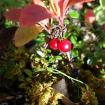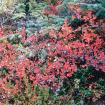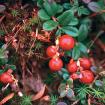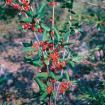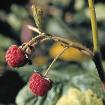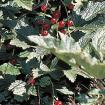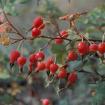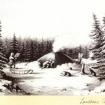Plants
Filter by categories
Over thousands of years, the Gwich’in have used a variety of trees, shrubs and berries for food, medicine, shelter and tools. Knowledge of this plant use has seriously declined in recent years.
In 1997, GSCI began work with Gwich’in elders on an ethnobotany project to record the use of this traditional knowledge in partnership with the Aurora Research Institute (ARI). The results of this research are available in a joint publication called “Gwich’in Ethnobotany: Plants Used by the Gwich’in for Food, Medicine, Shelter and Tools” by Alestine Andre and Alan Fehr.
The book highlights the use of 32 plants and 3 types of rocks and minerals. Information includes the Gwich'in names for these plants (in both the Gwichya Gwich'in and Teetł’it Gwich'in dialects), where they are found, and how they can be used. Several recipes for making medicine and preparing food are also included. Black and white and colour photographs illustrate the text.
Information from this book and a Master’s thesis by Alestine Andre (2006) called, Nan t’aih nakwits'inahtsìh (The Land Gives Us Strength) have been used to create our Gwich’in ethnobotany database. This database contains cultural knowledge about 43 plants traditionally used by the Gwich’in and is searchable by plant types and uses. You can click on any of the categories to the left to filter the records, or click on “By Type” or “By Uses” above to bring up all categories.
Please note that the plant information provided in this website is NOT a medical guide and must not be used for medical advice or self-medication. DO NOT USE any parts of a plant if you are not certain about the plant’s identity or its medicinal use. Please seek the advice of a local medicine plant specialist for plant information.
Gwich’in Plant Specialists – Ruth Welsh & Alestine Andre biographies
As food
The edible berries of this low-growing plant are similar to red currants. The red, shiny berries are juicy but sour. Ruth Welsh and Mary Kendi say if you do...
As food
Although not commonly found in the Gwich’in Settlement Region, the black berries of this plant are strong tasting and usually are picked for food in late...
As food
The berries are edible and make good jam. They are ready to pick in August and September and are tasty when eaten as is or eaten with other berries....
As food
Blueberries are tasty and can be eaten as is or used in jams, pies, muffins, and it’suh, a Gwich’in dessert made from pounded dry fish. As a medicinal tea,...
As food
Cranberries can be eaten raw or added to breads, pies and muffins. Cranberry jam, jelly or syrup can be made by boiling the berries in sugar with water. A...

